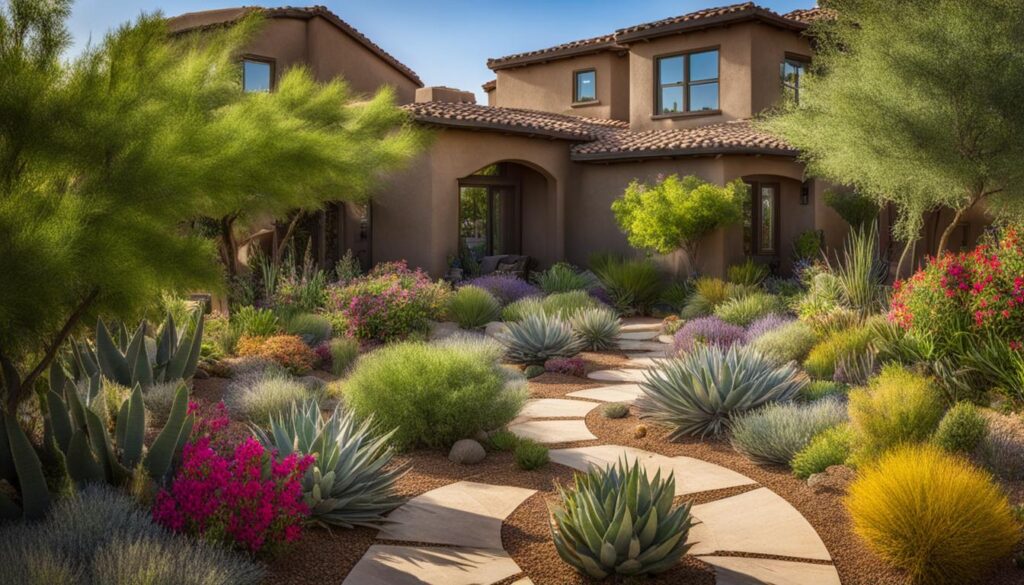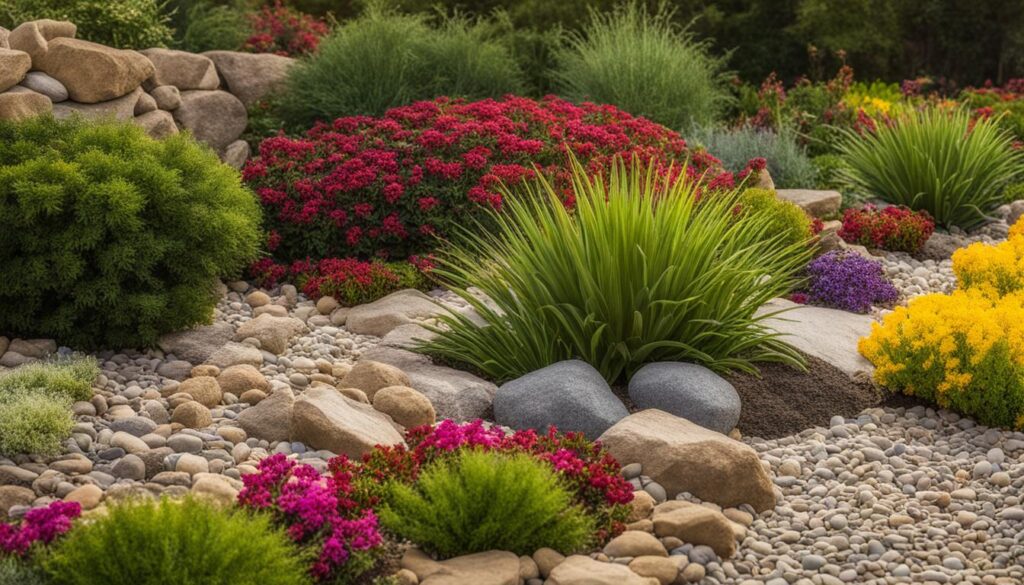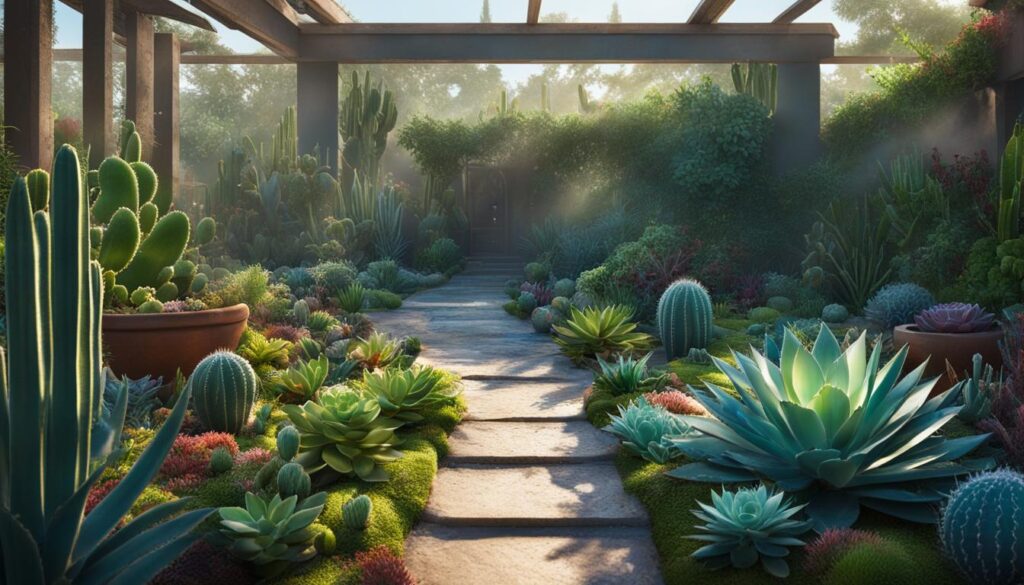In today’s world, where water scarcity is a growing concern, it’s essential to find innovative ways to conserve water. Xeriscaping, a landscaping technique that originated in the United States and has gained popularity in Australia, offers a sustainable solution. By implementing xeriscaping principles, you can create a beautiful, water-efficient landscape that not only reduces water usage but also helps control soil erosion. In this green guide, we will explore the key principles of xeriscaping, the benefits it offers, and how to implement it in your own landscape.
Key Takeaways:
- Xeriscaping is a landscaping technique that conserves water through a unique and creative design process.
- Implementing xeriscaping principles can reduce water usage in gardens by up to 30%.
- Xeriscaping offers benefits such as lower water bills, reduced maintenance, and a healthier, eco-friendly landscape.
- The six principles of xeriscaping include water-conserving design, soil amendment, appropriate hydrozones, covering open ground, smart use of turf, and efficient watering techniques.
- To implement xeriscaping, plan your landscape, conduct soil analysis, select appropriate plants, and establish efficient irrigation systems.
Understanding the Benefits of Xeriscaping
Xeriscaping offers a range of benefits for homeowners. It reduces water usage, leading to lower water bills and less reliance on scarce water resources. Xeriscaped gardens require less maintenance, as they are designed to be self-sufficient and drought-tolerant. By using native plants and appropriate hydrozones, xeriscaping promotes biodiversity and supports local wildlife. Additionally, xeriscaping eliminates the need for pesticides and chemical fertilizers, resulting in a healthier and more eco-friendly landscape.
One of the main advantages of xeriscaping is its water conservation capabilities. By incorporating water-efficient design techniques, such as mulching and strategic plant placement, xeriscaping significantly reduces the amount of water needed to maintain a lush and vibrant garden. This not only saves homeowners money on their water bills but also helps alleviate the strain on local water sources, particularly in regions prone to drought.
Another benefit of xeriscaping is its low maintenance requirements. Unlike traditional landscapes, xeriscaped gardens are designed to be self-sustaining and require minimal intervention. By selecting plants that are well-adapted to the local climate and soil conditions, homeowners can create a landscape that thrives with little to no supplemental watering, fertilizers, or pesticides. This not only saves time and effort but also minimizes the use of harmful chemicals, resulting in a healthier and more sustainable environment.
The use of native plants in xeriscaping also contributes to the preservation of biodiversity and the support of local wildlife. Native plants have evolved to thrive in the local ecosystem and provide essential food and habitat for native birds, insects, and other wildlife. By incorporating native plants into xeriscaped gardens and creating appropriate hydrozones based on plant water needs, homeowners can help restore and maintain the natural balance of their local environment.
Overall, xeriscaping is a sustainable landscaping approach that offers numerous benefits, including water conservation, reduced maintenance, and support for biodiversity. By embracing xeriscaping techniques, homeowners can create beautiful and eco-friendly landscapes that not only enhance the aesthetic appeal of their properties but also contribute to a greener future.
The Six Principles of Xeriscaping
Xeriscaping is a sustainable landscaping practice that aims to conserve water while creating beautiful and environmentally friendly landscapes. It is based on six key principles, each playing a vital role in water conservation and the overall success of a xeriscape garden.
Principle 1: Water-Conserving Design
The first principle of xeriscaping is water-conserving design. This involves carefully planning and designing the landscape to minimize water runoff and maximize water retention. Factors such as local rainfall, topography, and evaporation rates are taken into consideration to create a landscape that efficiently uses and conserves water.
Principle 2: Soil Amendment
The second principle is soil amendment. Xeriscaping involves modifying the soil to suit the water needs of different plants. This may include improving soil structure, adding organic matter for better water retention, and ensuring proper drainage. By optimizing the soil conditions, plants can access water more efficiently and thrive in a xeriscape garden.
Principle 3: Appropriate Hydrozones
The third principle focuses on creating appropriate hydrozones within the landscape. Hydrozones involve grouping plants with similar water requirements together. By clustering plants based on their water needs, it is easier to provide the right amount of water to each plant, avoiding overwatering or underwatering. This not only conserves water but also promotes healthier plant growth.
Principle 4: Covering Open Ground
The fourth principle is covering open ground. This involves minimizing exposed soil to prevent water loss through evaporation. Mulching is commonly used to cover the ground, reducing evaporation, suppressing weed growth, and improving soil moisture retention. By covering the open ground, xeriscaping helps conserve water and maintain a more sustainable landscape.
Principle 5: Smart Use of Turf
The fifth principle is the smart use of turf. Traditional lawns require significant amounts of water to stay green and healthy. In xeriscaping, the size of turf areas is minimized or replaced with drought-tolerant grasses or ground covers that require less water. By reducing the amount of turf, water usage is dramatically reduced while still maintaining a visually appealing landscape.
Principle 6: Efficient Watering Techniques
The sixth principle focuses on efficient watering techniques. Deep watering, which encourages plants to develop deep roots, and avoiding watering in the heat of the day are essential practices in xeriscaping. By watering efficiently, xeriscapers maximize water absorption and minimize water loss through evaporation. This ensures that water is used optimally and helps conserve water resources.
Implementing these six principles of xeriscaping can lead to a sustainable and water-efficient landscape. By carefully considering water conservation in landscaping, homeowners can create beautiful outdoor spaces while minimizing their environmental impact.
Implementing Xeriscaping in Your Landscape
Implementing xeriscaping techniques in your landscape can help create a beautiful and water-efficient garden. By following a few key steps, you can design a sustainable landscape that thrives in your local climate while conserving water. Here’s how to get started:
Step 1: Assess Your Property
Begin by creating a base map of your property to understand its characteristics and natural features. Take note of areas that receive more or less sunlight, as well as any slopes or drainage patterns. This assessment will help you determine the best placement for different types of plants and features in your xeriscape design.
Step 2: Plan and Design
Consider the needs of different areas in your landscape, such as recreational spaces and ornamental gardens, and plan accordingly. Choose plants that are native to your region and well-suited to the local climate. Group plants with similar water requirements together and create hydrozones to optimize water usage. Reduce the size of turf areas or replace them with drought-tolerant grasses.
Step 3: Irrigation and Mulching
Install efficient irrigation systems, such as drip irrigation, to reduce water usage and ensure plants receive water directly at their roots. Use mulches to conserve moisture in the soil and suppress weed growth. Organic mulches like wood chips or straw can also help insulate plant roots and regulate soil temperature.
Step 4: Maintenance
Establish a maintenance routine that includes proper fertilization, pruning, and water management. Regularly check for signs of pests or diseases and take appropriate actions to prevent or treat them. Adjust your irrigation schedule based on weather conditions and the specific needs of your plants. By maintaining your xeriscape landscape, you can ensure its long-term health and sustainability.
| Step | Description |
|---|---|
| 1 | Assess Your Property |
| 2 | Plan and Design |
| 3 | Irrigation and Mulching |
| 4 | Maintenance |
Xeriscaping in Long Island: Saving Water and Money
In Long Island, where water conservation is a growing concern, xeriscaping is becoming more common among homeowners. By implementing xeriscaping techniques, you can not only create a beautiful landscape but also save a significant amount of water, leading to reduced water bills and contributing to water conservation efforts in the region.
Compared to traditional landscapes, xeric landscapes in Long Island require less maintenance and are more environmentally friendly. By choosing drought-tolerant plants and reducing turf areas, homeowners can significantly reduce water usage. Xeriscaping also eliminates the need for pesticides and chemical fertilizers, creating a healthier and more sustainable landscape.
The benefits of xeriscaping in Long Island extend beyond water conservation. By embracing this water-saving landscaping approach, you can create a greener and more eco-friendly future. Xeriscaping promotes biodiversity and supports local wildlife by using native plants and appropriate hydrozones. It also reduces runoff and soil erosion, protecting the local ecosystem.
“Xeriscaping in Long Island allows homeowners to save up to 60-70% on their water bills while creating a sustainable, low-maintenance landscape.”
With its numerous benefits and increasing importance in water conservation and sustainability, xeriscaping is a smart choice for homeowners in Long Island. By implementing the six principles of xeriscaping and following best practices for water-efficient gardening, you can create a beautiful, eco-friendly landscape that saves water, reduces maintenance, and contributes to a greener future.
| Benefits of Xeriscaping in Long Island | Water-saving Landscaping | Reducing Water Bills |
|---|---|---|
| Significantly reduce water usage | Conserves water resources | Saves money on water bills |
| Low-maintenance landscape | Minimizes maintenance efforts | Reduces maintenance costs |
| Eco-friendly and sustainable | Eliminates the need for pesticides and chemical fertilizers | Creates a healthier environment |
| Promotes biodiversity | Supports local wildlife | Protects the local ecosystem |
Steps for Xeriscaping in Long Island Landscapes
Implementing xeriscaping in your Long Island landscape requires careful planning and execution to create a beautiful, water-efficient garden. Follow these steps to achieve a successful xeriscape:
Selecting the Right Plants
The first step in xeriscaping is choosing plants that are well-suited to the climate of Long Island and have low water requirements. Native plants are an excellent choice as they are naturally adapted to the local conditions. Consider factors such as sun exposure, soil quality, and the specific needs of each plant to create a harmonious and thriving landscape.
Designing for Water Efficiency
When designing your xeriscape, focus on water efficiency by grouping plants with similar water needs together. This practice, known as hydrozoning, ensures that plants receive the right amount of water without wastage. Incorporate features such as swales and berms to capture and direct rainwater, reducing the need for irrigation.
Efficient Irrigation Systems
Installing efficient irrigation systems is essential for water conservation in xeriscaping. Drip irrigation is particularly effective as it delivers water directly to the root zone, minimizing evaporation and runoff. Set up timers and moisture sensors to ensure precise watering, and avoid irrigating during the hottest parts of the day to prevent water loss.
Prioritizing Mulching and Soil Health
Mulching is a crucial aspect of xeriscaping as it helps retain moisture, suppress weeds, and regulate soil temperature. Use organic mulches such as wood chips or straw to conserve water and improve soil health. Additionally, amend the soil with organic matter to enhance its water-holding capacity and create an optimal environment for plant growth.
Establishing a Maintenance Routine
To keep your xeriscape in optimal condition, establish a regular maintenance routine. This includes proper fertilization, pruning, and weed control. Apply organic fertilizers to replenish nutrients and use natural weed control methods to avoid the use of harmful chemicals. Regular inspection and monitoring of plants will help identify any issues early on and ensure the long-term success of your xeriscape.
By following these steps, you can create a stunning and sustainable xeriscape in your Long Island landscape. Not only will you conserve water and reduce maintenance, but you’ll also contribute to a greener future.
The Importance of Proper Irrigation in Xeriscaping
Proper irrigation plays a crucial role in the success of xeriscaping. By implementing efficient watering techniques and strategies, you can not only ensure the optimal growth and health of your plants but also contribute to water conservation efforts.
One effective technique is deep watering, which involves providing a slow and deep soak to the plants’ root zone. This encourages the plants to develop deep and extensive root systems, making them more resilient to drought conditions. Additionally, deep watering promotes water retention in the soil, reducing the need for frequent irrigation.
Proper irrigation is not just about how much water you provide, but also about when and how you do it. Avoid watering in the heat of the day, as much of the water will evaporate before it reaches the plants. Instead, water in the early morning or late afternoon when the temperature is cooler.
Drip irrigation systems are particularly effective in xeriscaping. These systems deliver water directly to the root zone of plants, minimizing wastage through evaporation and runoff. By using drip irrigation, you can ensure that water is used efficiently and effectively, providing your plants with the moisture they need without excess usage.
The Benefits of Efficient Irrigation in Xeriscaping
Efficient irrigation in xeriscaping offers numerous benefits:
- Water conservation: Proper irrigation techniques help conserve water by minimizing wastage through evaporation and runoff.
- Cost savings: By using efficient watering strategies, you can reduce your water bill and save money in the long run.
- Healthy plants: Deep watering and drip irrigation systems promote the development of strong and healthy root systems, leading to robust and vibrant plants.
- Sustainability: By conserving water and using it wisely, xeriscapers contribute to a more sustainable environment and help protect precious water resources.
Remember, proper irrigation is not just about providing water to your plants; it’s about doing so in a way that maximizes efficiency and minimizes waste. By adopting efficient watering techniques, you can create a thriving xeriscape landscape while conserving water for a greener future.
Maintaining a Xeriscape Landscape
Once you have created a beautiful xeriscape landscape, it is important to maintain it properly to ensure its long-term health and sustainability. One of the key advantages of xeriscaping is its low-maintenance nature, but there are still some tasks that need to be done regularly to keep your landscape thriving.
Watering is an essential aspect of xeriscape maintenance. While xeriscape gardens are designed to be water-efficient, they still require irrigation, especially during dry periods. It is important to water deeply and infrequently, allowing the water to reach the roots of the plants. This encourages deep root growth and makes the plants more resilient to drought conditions. Regularly check the moisture levels of the soil and adjust your watering schedule accordingly.
Fertilizing is another important aspect of xeriscape maintenance. Organic fertilizers are recommended to promote healthy growth without harming the environment. Apply fertilizers according to the specific needs of your plants and follow the manufacturer’s instructions. Pruning is necessary to remove dead or damaged branches, maintain the shape of the plants, and promote proper air circulation. Regular weeding is also important to prevent invasive plants from taking over and competing for resources with your xeriscape plants.
By following these maintenance practices, you can ensure the long-term health and beauty of your xeriscape landscape. With its low-maintenance nature and sustainable design, xeriscaping is a smart choice for homeowners looking to create a beautiful and eco-friendly outdoor space.
Table: Xeriscape Maintenance Checklist
| Task | Frequency |
|---|---|
| Watering | Deep watering 1-2 times per week, adjust according to weather conditions |
| Fertilizing | Once or twice per year, following manufacturer’s instructions |
| Pruning | As needed, to remove dead or damaged branches |
| Weeding | Regularly, to prevent weed growth and competition |
Xeriscaping for a Greener Future
Xeriscaping is not just a trend but a sustainable landscaping practice that promotes water conservation and environmental stewardship. By embracing xeriscaping, homeowners can contribute to a greener future by reducing water usage, minimizing the need for chemical inputs, and supporting local wildlife. Xeriscaping offers a practical and eco-friendly approach to gardening that can be implemented in any region, including areas prone to water scarcity. With proper planning, design, and maintenance, xeriscaped landscapes can thrive and provide long-lasting beauty while minimizing their impact on the environment.
One of the key benefits of xeriscaping is its focus on sustainability. By reducing water consumption and using drought-tolerant plants, xeriscaped landscapes are able to thrive without placing a strain on precious water resources. This not only helps homeowners save on water bills but also supports water conservation efforts in regions with limited water supply.
Another advantage of xeriscaping is its eco-friendly nature. By minimizing the use of pesticides and chemical fertilizers, xeriscaping promotes a healthier and more natural environment. Additionally, xeriscaping incorporates native plants and encourages biodiversity, providing habitat and food sources for local wildlife. This creates a harmonious ecosystem where both humans and nature can coexist in a sustainable manner.
“Xeriscaping is a sustainable and practical approach to landscaping that offers numerous benefits, including water conservation, reduced maintenance, and environmental friendliness.”
Implementing xeriscaping techniques also contributes to green gardening practices. By choosing plants that are well-suited to the local climate and soil conditions, xeriscapers can create landscapes that require less maintenance and are more resilient to environmental challenges. This means less time spent on watering, mowing, and pruning, allowing homeowners to enjoy their outdoor spaces without the stress of constant upkeep. Additionally, xeriscaping reduces the need for fuel-powered lawn equipment, further reducing carbon emissions and contributing to a greener, more sustainable world.
Overall, xeriscaping is a practical and environmentally friendly approach to landscaping that offers long-term benefits for homeowners and the planet. By implementing xeriscaping principles and embracing sustainable practices, homeowners can create beautiful, water-efficient landscapes that promote a greener future. Whether you live in an area with water scarcity or simply want to reduce your environmental footprint, xeriscaping is a smart choice that combines aesthetics, functionality, and sustainability.
| Benefits of Xeriscaping | Reasons to Embrace Xeriscaping |
|---|---|
| 1. Water conservation | 1. Promotes sustainability |
| 2. Reduced maintenance | 2. Eco-friendly landscaping |
| 3. Environmental friendliness | 3. Supports green gardening |
| 4. Cost savings on water bills | 4. Creates a harmonious ecosystem |
| 5. Resilient to environmental challenges | 5. Reduces carbon emissions |
How Can Water Retention Techniques Help in Controlling Soil Erosion in Xeriscaping?
Xeriscaping can greatly benefit from revolutionize garden water retention techniques. Implementing methods such as mulching, rain gardens, and contouring can help soil retain water more effectively, reducing erosion. By using these techniques, xeriscaping can thrive in drier conditions while minimizing water usage.
Conclusion
Xeriscaping is a sustainable and practical approach to landscaping that offers numerous benefits for your outdoor space. By implementing the six principles of xeriscaping, you can create a beautiful and water-efficient landscape that minimizes soil erosion and promotes a greener future.
One of the key advantages of xeriscaping is its ability to conserve water. With the growing importance of water conservation, implementing xeriscaping techniques can help reduce your water usage and contribute to a more sustainable environment.
Additionally, xeriscaping offers the benefit of reduced maintenance. By designing your landscape with drought-tolerant plants, minimizing turf areas, and using efficient irrigation systems, you can enjoy a low-maintenance garden that requires less watering and upkeep.
Overall, xeriscaping provides a practical and eco-friendly solution for sustainable landscaping. By embracing this approach, you can create a beautiful outdoor space while minimizing your impact on the environment and enjoying the benefits of a water-efficient garden.














